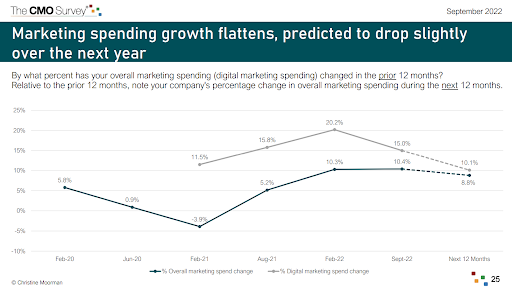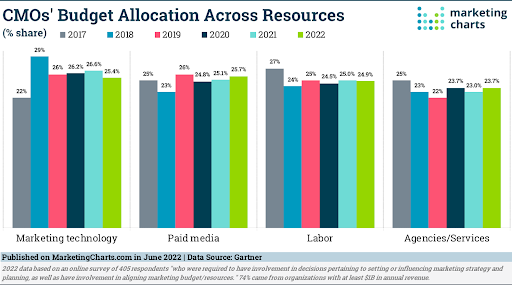
 The latest B2B Content Marketing Benchmarks, Budgets and Trends Report found that 67% respondents are being asked to do more with the same resources compared to a year ago. Many teams will keep being pressed to work under constraints in the coming year as economic uncertainty affects planning and budgets. In the latest CMO Survey, released in September, results showed that marketers “generally expect the growth of their marketing spending to slow or be flat in the coming year,” with waning optimism around the economic outlook likely a central factor.
The latest B2B Content Marketing Benchmarks, Budgets and Trends Report found that 67% respondents are being asked to do more with the same resources compared to a year ago. Many teams will keep being pressed to work under constraints in the coming year as economic uncertainty affects planning and budgets. In the latest CMO Survey, released in September, results showed that marketers “generally expect the growth of their marketing spending to slow or be flat in the coming year,” with waning optimism around the economic outlook likely a central factor.  (Image source) The most reliable way to drive marketing results is to (smartly) invest more. This can lead to more ambitious campaigns and more robust promotion, among other things. But when a big budget isn’t available, B2B marketers can still do big things. Whether your company is facing a crunch and scaling back, or you’re a small business marketer looking to drive growth with limited resources, here are some tips for maximizing the bang for your buck in today’s environment.
(Image source) The most reliable way to drive marketing results is to (smartly) invest more. This can lead to more ambitious campaigns and more robust promotion, among other things. But when a big budget isn’t available, B2B marketers can still do big things. Whether your company is facing a crunch and scaling back, or you’re a small business marketer looking to drive growth with limited resources, here are some tips for maximizing the bang for your buck in today’s environment.
5 Ways to Maximize the Impact of Your Marketing Budget
#1: Gain ground by investing in brand.
When under pressure to show the impact of marketing efforts, there’s a natural compulsion to lean into lower-funnel, sales activation campaigns aimed at quick wins. But research has shown that doing so at the expense of brand-building investment is misguided, for two reasons:- If your budget is down because of challenging economic conditions, there’s a good chance your buyer audience is also pulling back on spending. This means conversion-focused content is less likely to resonate and deliver ROI. Even the best lead gen ads won’t compel someone to make a purchase when they’re simply unable to do so.
- Moreover, since many of your competitors are likely reducing brand investments during such times, there is a greater advantage to be gained by bucking that trend and tapping into the heightened opportunity. “The companies who don’t make knee-jerk reactions are positioned well to catapult out of tough times,” wrote Metadata.io’s Jason Widup recently, “because everyone around them is pulling back, which creates more space in the areas you’re advertising in to get in front of the right people at a lower cost.”
#2: Ground your creative risks and experimentation within data-informed guidelines.
Strong brand-building campaigns are inherently fueled by creatively effective approaches. By definition, creativity requires a certain level of experimentation and risk-taking. This leads budget-conscious marketers to a conundrum: how can we afford to take these risks? The answer: by minimizing them. Today’s leading data-driven marketers are bringing structure to creativity by embedding platform-specific guidelines, which can often be informed by the platform providers themselves. For example, YouTube offers a set of guidelines called the ABCDs (Attention, Branding, Connection, Direction), which provide a dependable framework for video advertising effectiveness – following them has been shown to produce a 30% lift in short-term sales likelihood and a 17% lift in long-term brand attribution. LinkedIn recently shared a set of creative best practices for advertising on their platform, including specific tips for each format. Our clients at CreativeX have built a platform designed to measure and leverage creative data in powerful and advanced ways. I highly recommend checking out their content to learn more about the science behind this movement. Michael Murray’s blog post on When efficient = effective is a great place to start. “Efficiency doesn't have to be a bad thing, nor a dirty word,” he wrote. “A highly effective brand, one that has invested heavily in creating future demand and that successfully balances the Long and the Short, can also be efficient at driving sustained sales volume in the short term.”#3: Spend wisely on marketing technology.
A new report shows that martech spending is expected to break $20 billion this year. This 14.3% increase would be a step back from last year’s $20.9 spike, but still it’s clear that marketers are racing to equip themselves with a winning tech stack. Marketing technology is consistently one of the biggest sources of budget allocation for CMOs. (Image source) Investing in technology is important, and critical to the efficiency of your operation. But when scrutinizing a tight budget, it’s always worth revisiting your tool set in search of opportunities to cut or consolidate. In a recent interview with Martech Series, Canto CMO Erica Gunn offered a simple piece of advice: “Don’t do too many things at once, and make sure the investments you make will actually have an impact on how you run marketing as a business.” Last year, Harvard Business Review offered a three-step model for creating a top-down marketing tech stack:
(Image source) Investing in technology is important, and critical to the efficiency of your operation. But when scrutinizing a tight budget, it’s always worth revisiting your tool set in search of opportunities to cut or consolidate. In a recent interview with Martech Series, Canto CMO Erica Gunn offered a simple piece of advice: “Don’t do too many things at once, and make sure the investments you make will actually have an impact on how you run marketing as a business.” Last year, Harvard Business Review offered a three-step model for creating a top-down marketing tech stack:
- Deconstruct your customer journey
- Decompose your marketing strategy into tactics
- Design your martech stack accordingly
#4: Focus more on post-sale customer engagement.
As we’ve already established, it doesn’t make a ton of sense to invest heavily in directly acquiring new customers when economic conditions are suppressing purchase activity. It does, however, make all the more sense to double-down on your existing customers in efforts to shore up loyalty and secure growth opportunities. Forrester recently shared at Forbes that “34% of marketing decision-makers who have management authority of customer engagement, plan to increase the budget for customer engagement headcount by 10% or more. The primary focus being tied between increasing the value of post-sale engagement programs by sharing customer experiences and demonstrating the impact of customer advocacy and references.” New research by Alloy found that while “73% of B2B software companies have accelerated existing customer revenue goals over the past 12 months,” and that “41% of these brands are decreasing their emphasis on net new sales due to the prioritization of up- and cross-selling initiatives.” They’ve got the right idea.#5: Find the right partners and support.
Even with the right processes and practices in place, you still need people to do the work. That’s a prime challenge for today’s marketing leaders, because according to Gartner, 58% of CMOs report that their teams lack the capabilities needed to execute on their strategy. Reduced budgets can make it nearly impossible to bring in the requisite full-time talent. In this environment, experienced agency partners can be invaluable. Not only can the right partner help fill resource gaps, but they can also help bring efficiency to your efforts through expertise and strategic consultation.Make Every Marketing Dollar Count
The threat of an economic downturn can understandably cause a lot of apprehension for anyone who is held accountable for business growth. As a marketing leader, the best thing you can do is view moments like these as opportunities. Recognize that you can control only what you can control, align your approach to changing customer circumstances, and make the most out of what you’ve got. You don’t need a big budget to do big things. * LinkedIn is a TopRank Marketing clientThe post B2B Content Marketing: Making Small Budgets Do Big Things appeared first on B2B Marketing Blog - TopRank®.
0 Commentaires